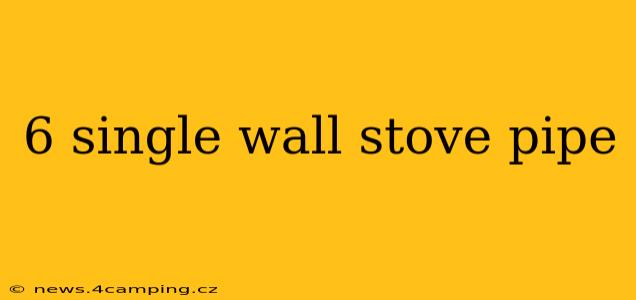6" Single Wall Stove Pipe: A Comprehensive Guide
Choosing the right stove pipe is crucial for safe and efficient wood stove operation. A common size is 6" single wall stove pipe, but understanding its characteristics and limitations is vital before installation. This guide will delve into the specifics of 6-inch single wall stove pipe, addressing common questions and concerns.
What is 6" Single Wall Stove Pipe Used For?
6" single wall stove pipe is primarily used to connect wood-burning stoves and fireplaces to their chimneys. Its diameter dictates the airflow and exhaust capacity, making it suitable for stoves with corresponding output requirements. Always check your stove manufacturer's instructions for the recommended pipe size and type. Using the incorrect size can lead to inefficient burning, creosote buildup, and even fire hazards. This pipe is typically used for shorter runs, as longer lengths necessitate double-wall pipe for increased safety.
What are the Advantages of 6" Single Wall Stove Pipe?
- Cost-Effective: Single wall pipe is generally less expensive than its double-wall counterpart. This makes it a budget-friendly option for shorter, less exposed runs.
- Lightweight: Its lighter weight simplifies installation, particularly in DIY projects.
- Simple Installation: The design is straightforward, making it easier to assemble and connect than more complex piping systems.
What are the Disadvantages of 6" Single Wall Stove Pipe?
- Heat Transfer: The significant drawback of single wall pipe is its direct heat transfer to surrounding materials. This presents a fire hazard if not installed with proper clearances and precautions. Always maintain the required clearances specified by the manufacturer and local building codes.
- Not Suitable for Long Runs: Extended runs of single wall pipe are strongly discouraged due to the risk of overheating surrounding surfaces and the potential for structural damage.
- Creosote Buildup: While regular cleaning is recommended for all stove pipes, single wall pipe can experience increased creosote buildup due to the lower temperatures in some sections. This necessitates more frequent cleaning to maintain efficiency and safety.
What is the difference between single wall and double wall stove pipe?
The key difference lies in the pipe's construction. Single wall pipe consists of a single layer of metal, while double wall pipe has an inner and outer layer with insulation in between. This insulation significantly reduces the amount of heat transferred to the surrounding area, making double wall pipe safer for longer runs and installations where the pipe passes through combustible materials.
Is 6" single wall stove pipe safe?
6" single wall stove pipe can be safe when installed correctly and within the parameters specified by the manufacturer and building codes. However, its inherent tendency to transfer heat makes it crucial to follow safety guidelines meticulously. Improper installation can lead to serious fire hazards. Always consult a professional if you have any doubts about your installation.
How often should I clean my 6" single wall stove pipe?
The frequency of cleaning depends on several factors, including the type of wood burned, the efficiency of the stove, and the length of the pipe. However, as a general guideline, a minimum of once per heating season is recommended, and more frequent cleaning might be necessary, especially if you notice significant creosote buildup. Creosote is highly flammable and can lead to chimney fires.
Where can I buy 6" single wall stove pipe?
6" single wall stove pipe is widely available at home improvement stores, hardware stores, and online retailers specializing in fireplace and stove supplies. However, remember to always verify that the pipe meets local building codes and safety standards.
This guide provides a comprehensive overview of 6" single wall stove pipe. Remember, safety should always be your top priority when installing and using any stove pipe. If you are unsure about any aspect of the installation process, consult a qualified professional.
